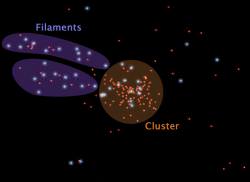Galaxies, like people, tend to stick together. These galaxies collect together into communities large and small, called clusters and even superclusters. According to new research gathered by NASA's Spitzer Space Telescope, stars seem to form better in the cosmic suburbs of these clusters.
Galaxy clusters can be enormous, locking together thousands of galaxies into a mutual gravitational dance. Seen from afar, these groups of galaxies form large blobs (the clusters) linked together by spider web-like filaments that stretch for millions of light-years. The filaments contain the smaller collections of galaxies working their way towards the largest clusters.
Spitzer's infrared view revealed two of these filaments in the galaxy cluster Abell 1763. Galaxies are traveling along these filaments, and will eventually collide with the larger cluster itself.
The researchers used Spitzer to measure the rates of star formation in both filaments and the larger galaxy cluster itself. They found that the filaments have much higher rates of star formation than the cluster.
"This is the first time we've ever seen a filament leading into a cluster with an infrared telescope," says Dario Fadda, of the Herschel Science Center, which is located at the California Institute of Technology in Pasadena, California. "Our observations show that the fraction of starburst galaxies in the filaments is more than double the number of starburst galaxies inside the cluster region."
Upcoming space missions, such as ESA's Herschel Space Telescope, will take these infrared observations to the next level, watching how filaments and clusters affect the growth of galaxies in greater detail.
 Universe Today
Universe Today
